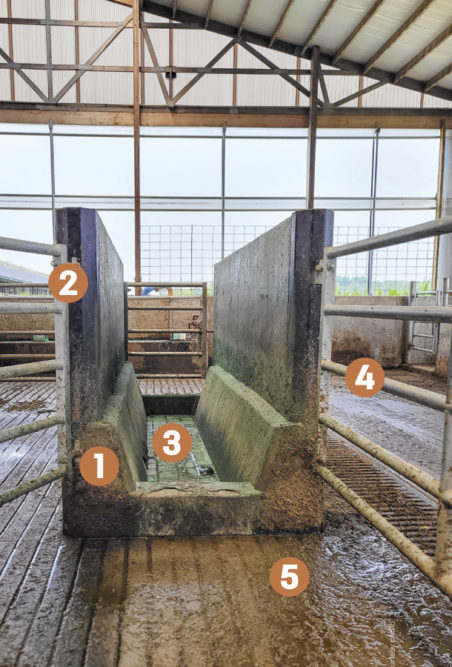In order for dairies to manage digital dermatitis, it is essential to have a footbath designed for cow comfort, ease of use and effectiveness.
As part of the Professional Dairy Producers (PDPW) Hoof Health Workshop series held last summer, Dr. Gerard Cramer, associate professor at the University of Minnesota, walked attendees through the footbath set up at Brooks Farms in Waupaca, Wisconsin. Here, he highlighted key components of a successful footbath program to keep digital dermatitis under control.
According to Zoe Brooks Nelson, the 600-cow Holstein herd has experienced less than a handful of hairy warts in the past year. They maintain good hoof health and hygiene by running the footbath twice weekly.
- Curb height. Cramer recommended a curb height of 10 to 11 inches to allow for whole-hoof immersion. This also keeps solution in the bath and prevents it from splashing out.
- Sidewalls. At Brooks Farms, a solid concrete wall on either side of the bath helps to funnel cows in and keep them moving through while minimizing the outside distractions of the busy holding area. Cramer offered that plastic sheeting could be an alternative to the concrete if there are concerns about the cow going down and needing assistance getting out.
- Good footing. Brooks’ footbath provides good traction to prevent cows from slips and falls. The base has not only a cobblestone pattern, but it is also epoxied with a gritty surface for additional stability.
- Gates. The gate system is designed for both ease of use for workers and smooth flow for cows to funnel them through a single-file footbath lane upon exiting the milking parlor.
- Sloped floor. The floor around the footbath is slightly sloped, which allows water to drain away from the bath versus sitting. This keeps the surface drier and less slippery to prevent injury.
With a functional footbath in place, Brooks is able to closely adjust the frequency of baths should problems occur.
“Digital dermatitis is a dial,” Cramer explained. “If you think you have too much, turn the dial on your footbath.”
4 tips for using formalin in footbaths
Brooks Farms uses two products with one being formalin, an aqueous solution of formaldehyde in water, as their footbath disinfectant. One of the benefits of this option is: It is not a heavy metal like copper sulfate, which may lead to higher copper levels in the soil, and therefore forages, when manure is spread on the land. However, formalin does pose a human health risk. As a known carcinogen associated with nasal cancer, it must be handled with care.
“I’m a fan of formalin if we are setting it up so no one is handling the product,” Cramer says.
He offers these four tips:
- Set up for touch-free administration. No worker should come in close contact with formalin. Use automatic filling systems so people do not have to transport the solution to the bath and risk inhaling the fumes or getting it on their skin.
- Ventilate the area around the footbath. Formalin should not be inhaled. Avoid using it in enclosed areas, and use fans to create air movement.
- Store indoors in the winter. Ideally, formalin should be stored above 32ºF because at colder temperatures, the methanol can separate. This lowers the concentration of the solution, making it less active.
- Monitor concentration. The ideal concentration level for formalin is 1% to 2%. At levels greater than 5%, it can have a damaging effect on skin tissue.









